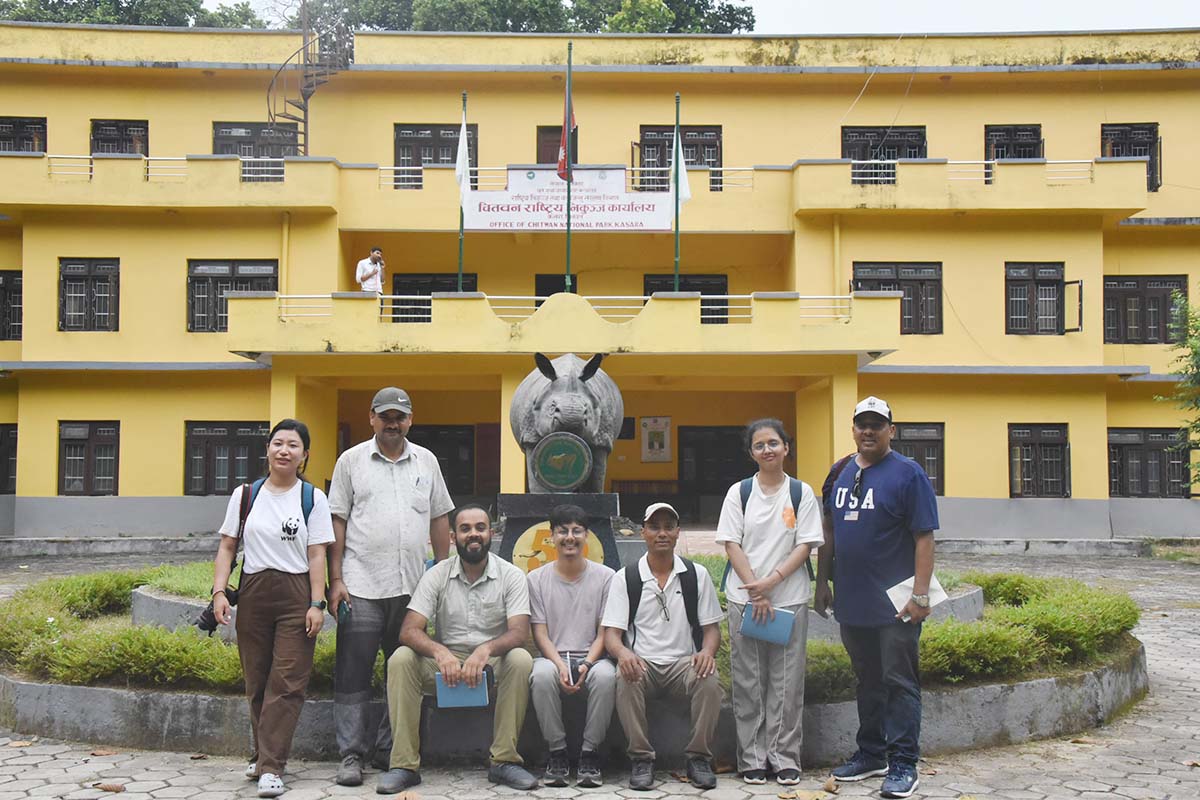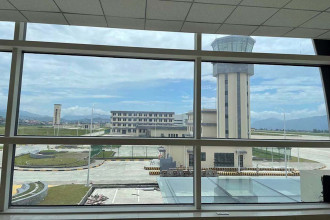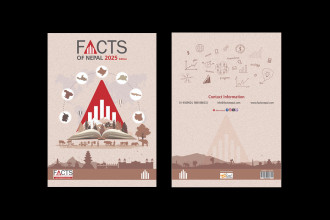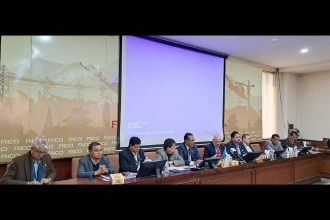
On the morning of September 24, we flew from Kathmandu to Bharatpur Airport in Chitwan. WWF Nepal had organised a three-day exposure visit for media persons to Chitwan National Park (CNP) and Parsa National Park, which are home to Bengal tiger, one-horned rhinoceros, leopard, sloth bear, gaur, elephant, gharial and mugger crocodiles, and various species of deer among others.
Seven of us, including two representatives from WWF Nepal, arrived at Bharatpur Airport, where another representative from the organisation welcomed us.
We were also welcomed by the pitter-patter of rain, but soon the sun shone brightly, and we could feel the heat. We took a drive to the Safari Narayani Hotel. On the way, we saw a long procession of women from the Tharu community and elephants parading along the road, dancing to the tunes of musical instruments. It was the beginning of the Tharu festival Jitiya. We enjoyed the view of people from the Tharu community, indigenous to Chitwan, in their white and red traditional attire.
After lunch, we attended a briefing conducted by Prem Poudel, WWF Nepal’s Cluster In-charge for the Terai Arc Landscape (TAL) programme - Eastern Cluster. It was fascinating to learn about WWF Nepal’s vision to establish corridors linking various national parks, facilitating wildlife migration across Nepal.
WWF aims to connect landscapes such as Sacred Himalayan Landscape (SHL), Kanchenjunga Landscape (KL), Chitwan Annapurna Landscape (CHAL), Kailash Sacred Landscape (KSL), and Terai Arc Landscape (TAL) including two new proposed landscapes: Karnali Conservation Landscape (KCL) and Eastern Chure Terai Complex (ECTC). The construction of these corridors is expected to mitigate human-wildlife conflict by allowing wildlife to migrate freely between parks, thus reducing disturbances to human settlements. This initiative is expected to enhance breeding opportunities among wildlife populations, promoting natural harmony and diversity.
Later that day, we drove to the Office of Chitwan National Park Kasara. Our group had the opportunity to meet Senior Conservation Officer Dil Bahadur Purja Pun. We discussed the ongoing conservation efforts made by the CNP.
The discussion focused on how the office manages wildlife conservation and the plans to minimise the ongoing human-wildlife conflict in the buffer zones. The CNP significantly contributes to the national economy. Last fiscal year, the CNP witnessed a significant increase in tourist arrivals with 306,837 visitors compared to 299,412 the previous year, generating income of Rs 267.15 million from tourism activities.
Regarding wildlife attacks on locals residing in the buffer zones, the park provides compensation to affected individuals. Each family of those killed in wildlife attacks receives Rs 1 million, while those with severe injuries are compensated up to Rs 130,000, depending on the severity.
Next, we visited the Gharial Conservation Breeding Centre, home to around 250 gharials. We were intrigued to learn that the sex of gharials is determined by the temperature at which their eggs are incubated. The lower incubation temperatures produce females, while higher temperatures produce males. A few months ago, there were only six males out of 267 hatches. Sujita Shrestha, Senior Conservation Officer at the centre, informed us that illegal fishing was the primary cause of death or injury for these critically endangered species.
Presently, there are approximately 770 gharials in Rapti and Narayani rivers, according to Shrestha. The breeding centre currently spends around Rs 900,000 every month to feed the gharials. The federal government has allocated a budget of Rs 2 million for crocodile and tiger conservation at CNP in the current fiscal year, down from Rs 3 million the previous year.
We wanted to go on a short safari in the national park but the muddy tracks hindered our attempt. Though autumn runs from mid-September to mid-November, this year the monsoon lingered. That’s why the CNP was still repairing and maintaining trails damaged by monsoon-related disasters. We walked back crossing the bridge over Rapti River on foot. The air around the national park was clean, green and healthy.
On the second day, we explored a community forest established to create grasslands for chital and tigers. The four community forests — Rapti Hariyali, Malika, Radhakrishna, and Sadabahar — in the buffer zones are being developed as tourist destinations. Rapti Hariyali Community Forest President Yamraj Thapa Magar highlighted that locals have improved their care for wildlife and no longer engage in poaching. With support from WWF Nepal, they have recently constructed ponds for rhinos.
The tourists were redirected to Radhakrishna Community Forest, where they could spot tigers, rhinos, and elephants. There were CCTV cameras installed to monitor wildlife. We explored the community forest. As it was rainy weather, we did not see any tigers. However, we came across herds of deer in the dense forest.
We stopped by a farm of fiddlehead ferns also called niuro, on our way out of the community forest. The farm was protected by fencing to prevent wild animals from entering. Locals no longer need to enter the park to collect the vegetables. This is a good way to avoid wildlife attacks. Outside the community forest, we encountered two Tharu women heading into the community forest to collect algae from the river, which they feed to their ducks. Locals believe algae to be the best nutrition for ducks.
At Tilauri Bazar, we met a woman running a tailoring shop established with support from WWF Nepal through its TAL programme. In the fiscal years 2022/23 and 2023/24, WWF Nepal had launched initiatives to improve the livelihoods of community members who relied solely on natural resources from Meghauli Community Forest. Individuals from these communities including single and poor women, and persons with disabilities, were each provided Rs 24,000 to establish businesses, according to Yubaraj Ghatane, Field Supervisor, TAL programme - Eastern Cluster. We also met Tukaram Mahato, who shared that the TAL programme helped him set up a four-wheeler cart shop to sell panipuri and other homemade snacks. He seemed quite happy that he earned Rs 1,500 daily on average on daily basis through the business.
We saw safe sheds for goats in the human settlements in buffer zones. The metal nets were used to cover the sheds to prevent wild animal attacks. Of the 108 households involved in goat farming in Chainpur, Madi Municipality-1 of Chitwan, 88 households had safe sheds installed by June 9, 2024, making it a model village for improved goat sheds, a hoarding board read.
We drove through through the CNP, heading to Madi. After a delicious lunch at the Bote Community Homestay in Bankatta, we headed to Pandavnagar, where we met with community members, a group of children, teenagers, and senior citizens. We had an interaction with a woman involved in raising awareness among youths about ways to avoid human-wildlife conflict. We also met members of Chetanshil Mahila Samuha, a women’s group involved in turmeric farming.
Passing through a picturesque village surrounded by green fields, we reached Kalyanpur Community Forest. There were several homestays in excellent condition. Tourists were enjoying the peaceful country lifestyle.
The southeastern part of Madi is famous for fish farming. Madi is surrounded by CNP on three sides. In the past, this area had struggled with human-wildlife conflict, with rhinos and elephants frequently damaging crops. Now the locals have transitioned from traditional paddy cultivation to fish farming. This has proven effective in mitigating wildlife incursions. Over 135 farmers are part of Madi Fish Production and Distribution Cooperatives, that manages fish ponds across 700 hectares of land. Beyond economic benefits, fish farming has significantly reduced human-animal conflict, as the ponds act as natural barriers, keeping the pachyderms away from human settlements.
We stayed overnight at Magar Homestay run by Pun Samaj in Kharkatta, Madi. The dal bhat there was delicious, and the night was chilly.
The next day, we headed for Thori through Ayodhyapuri, where we visited a temple. This is the place where Prime Minister KP Sharma Oli had claimed to be the real birthplace of Lord Ram. His remarks had sparked significant backlash from both Indian and Nepali communities.
Thori, located near the Indian border, is where Chitwan and Parsa National Parks converge with India’s Valmiki Tiger Reserve. Thori was once the main route for smugglers and those involved in poaching and human trafficking.
We had a meeting with Nirmal Thori Consumers’ Committee Chair, Bal Kumar Basnet. The committee has been involved in protecting wildlife from poaching and halting the smuggling of wildlife body parts. “We have set an example in improving corridors between national parks to reduce human-wildlife conflict, and Indian authorities are keen to learn from our strategies and initiatives,” Basnet shared.
We could see the Indian settlements on the opposite bank of a river. Thori Park attracts a large number of domestic as well as Indian tourists. They often visit the park to enjoy the natural surroundings, with many of them engaging in picnics. The park features a huge statue of a Bengal tiger and is a popular spot for nature lovers.
We continued eastward, enjoying the smooth road with green vistas of vegetation from Parsa National Park on our left and Valmiki Tiger Reserve on our right.
In Subarnapur, we met Bhim Bahadur Pakhrin, Chairperson of Sunakhari Consumers’ Committee. He shared his early struggles to save the forests from timber smugglers. With the deforestation in Parsa National Park, then Parsa Wildlife Reserve, the human settlements in the buffer zones faced scarcity of water after wood smugglers felled a large number of sal trees daily, Pakhrin shared. However, with reforestation in place, the area soon recovered to its original state.
In one and a half hours we reached Jitpur Simara Airport for the flight back to Kathmandu.
Our journey through the national parks showcased the region’s rich biodiversity and cultural heritage and also underscored the pivotal role of WWF Nepal in conservation and community development.






